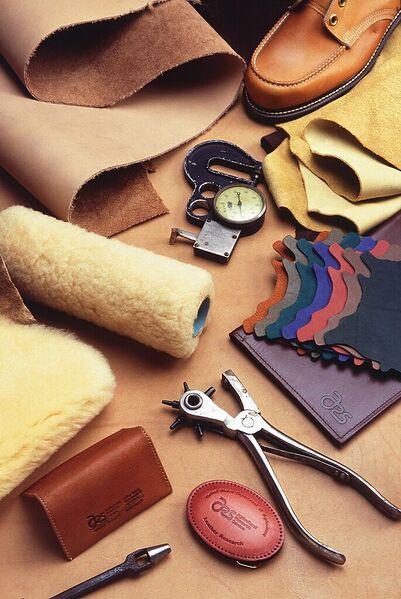
Original file (685 × 1,024 pixels, file size: 200 KB, MIME type: image/jpeg)
Summary
| Description |
English: Leather-making is an ancient craft, but it's met up with some state-of-the-art technology. Electron beam radiation, we've found, can replace the salt solutions now used to kill bacterial growth-much to the benefit of the environment. Not only is brine curing corrosive to equipment; it contributes to water pollution. We also found a way to reduce the number of poor-quality hides that make their way into leather processing. Laser light-scattering photometry can be used to evaluate hides according to the orientation of their fibers. High-tech detective work has tracked down a cause of shoemaking woes. One type of leather, which broke under the stress of manufacture, was found to have a genetic defect that's specific to certain Hereford cattle. It was ARS researchers who identified cockle, a seasonal flaw of sheepskin, as the work of a parasitic insect called keds. Once they realized that keds not only lowers the value of the skin but also causes sheep to grow more slowly, sheep farmers began treating their herds to control infestations. |
|---|---|
| Source | |
| Date | |
| Author |
Scott Bauer |
| Permission (Reusing this file) |
|
File history
Click on a date/time to view the file as it appeared at that time.
| Date/Time | Thumbnail | Dimensions | User | Comment | |
|---|---|---|---|---|---|
| current | 13:41, 23 April 2024 |  | 685 × 1,024 (200 KB) | Isidore (talk | contribs) | {{Information |Description = {{en|Leather-making is an ancient craft, but it's met up with some state-of-the-art technology. Electron beam radiation, we've found, can replace the salt solutions now used to kill bacterial growth-much to the benefit of the environment. Not only is brine curing corrosive to equipment; it contributes to water pollution. We also found a way to reduce the number of poor-quality hides that make their way into leather processing. Laser light-scattering photometry can... |
You cannot overwrite this file.
File usage
The following 2 pages use this file: